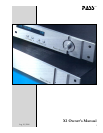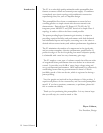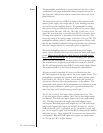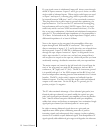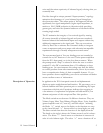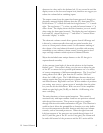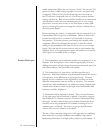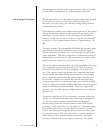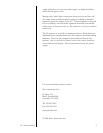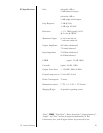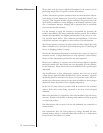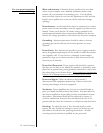
7
X1 Owner’s Manual
totally transparent. When the user chooses “Unity” this sets the X1’s
gain to the low (+4dB) setting, regardless of how it was previously
configured. When at Unity both left and right level controls on
the X1 will have a displayed value of 24, and any previous balance
settings will be lost. Both of these default conditions are intentional,
and intended to make the most advantageous use of your source
electronics. You may also set any of the four inputs to unity (0dB
gain) by selecting low gain and setting the volume to indicate 24 on
the front panel display.
Before selecting this option, it is imperative that the input device on
input number 4 has its gain set to minimum. Failure to follow this
precaution could result in a volume level intolerable to both ears
and speakers. To further protect your hearing and valuable audio
equipment, Wayne has designed this product so that the volume
setting of the preamplifier will always revert to zero as you change
inputs. We trust that the remote control, with its four buttons that
duplicate those of the preamp front panel will enable you to quickly
select inputs and establish levels of output.
1) Circuit simplicity and a minimum number of components is a key
element. The fewer parts in series with the signal path, the better.
Adding more parts and gain stages may improve measured specs, but
will seldom improve the perceived sonic quality.
2) The characteristic of gain devices and their specific use is
important. Individual variations in performance between like devices
are important, as are differences in topological usage. All signal
bearing devices contribute to the degradation, but there are some
different characteristics that are worthy of attention. For example,
smooth low order nonlinearities are additive in quality, bringing false
warmth and coloration, while abrupt high order nonlinearities add
harshness and false brightness.
3) Maximum intrinsic linearity is desired. This is the performance
of the gain stages before feedback is applied. Experience suggests
that feedback is a subtractive process; it removes information from
the signal. In many older designs, poor intrinsic linearity has been
factored out by large application of feedback, resulting in loss of
warmth, space, and detail. The trick is to get good performance
without this excessive reliance on feedback.
The art of high end audio design lies in the approach to combining
these elements to get high reliability and simplicity, high quality
measured performance, and high quality subjective performance. It
Product Philosophy



